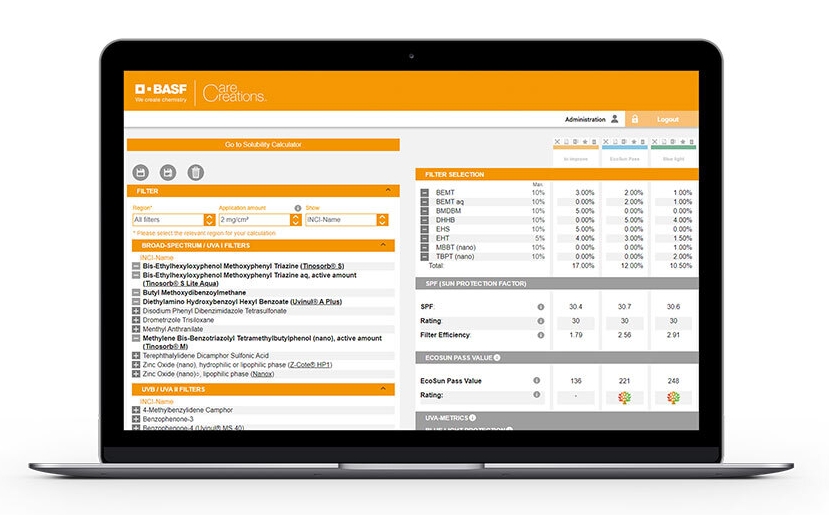
Sun protection
Create, calculate, predict - sun protection must be suitable
Laboratory conditions usually have little to do with life outside. Is this true? Not quite. With the BASF Personal Care Sunscreen Simulator, formulators and manufacturers of sun protection products can work with results that are increasingly closer to real life.
The requirements for sun protection products are high and varied. They must provide protection against sunburn, significantly reduce the risk of skin cancer and should virtually stop UV-related aging. In order to achieve all this, you need a) a high protection performance across the entire light spectrum and b) a good and sensible combination of UV filters, oils and other components of the formulation. The number of possible combinations is almost infinite.
Comparisons are generally either misleading or far-fetched. In this case, however, a comparison is also simply fun. What do Formula 1 stars like Vettel, Hamilton etc. have in common with well-known manufacturers of sun creams, sun lotions etc.? Both are using digitalization to constantly improve and at the same time work more cost-effectively.
While racing drivers want to familiarize themselves with new tracks in the simulator in their factories, find faster gearshifts and the right set-up for their vehicles, researchers and formulators in their laboratory can use the Sunscreen Simulator digital tool to create sun protection products that completely fulfil their wishes and, above all, do what the end users need.
Driven by their curiosity, people actively explore their environment from an early age; they seek out new situations to learn from them. They manipulate 100 objects in their environment in many ways, and their curiosity only ends once they are familiar with the object or the situation or when they have solved the task that was set for them.-
Eibl-Eibesfeldt
1984, "The Biology of Human Behaviour"
The need for digitalization in the research and laboratory sector was already recognized 20 years ago. Because the Sunscreen Simulator is by no means new, it is the pioneer. The field of application of the simulator extends far beyond the area of formulators. The digital tool not only serves the experts; students also work with it. Whether in America, Asia or Europe - the Sunscreen Simulator is used worldwide.
Thanks to continuous development and an ever-increasing wealth of experience, the results in the digital laboratory are getting ever closer to real life: "We have carried out a large number of in vivo tests in recent years and compared the calculations of our Sunscreen Simulator with these results," says Schnyder. "Based on these empirical values, there is a good correlation between in silico and in vivo."
Users are also provided with a user interface that constantly improves and becomes more comprehensive. "Our customers can digitally simulate the UV protection of a new formulation without having to do the hard work in the laboratory," emphasizes Schnyder. The place where the work takes place changes from the laboratory to the desk. In this way, costs for necessary in vivo tests can be enormously reduced for the manufacturer.
The Sunscreen Simulator now serves as a recognized tool / benchmark in the industry to determine the sun protection factor (SPF). But the development continues. In addition to the known performance parameters (SPF, UVA protection, photostability), you can now also perform calculations to protect against blue light irradiation and free radicals’ generation.
The implementation of EcoSun Pass is a tremendous step forward for formulators. In addition to the performance of their UV filter combinations and formulations, the environmental impact of the selected UV filter system can now also be directly verified.
The Solubilizer Simulator, a part of the Sunscreen Simulator that evaluates interaction between UV filters and emollients and provides information about the naturalness of the emollients, is also completely new. BASF experts are also available to help manufacturers find the right sun protection formulation. Access to some "finished" formulations helps in the search for the desired product.
in vivo test: It is derived from the Latin vivus and is derived from living life. Reactions on or in the living organism are tested.
in silico test: From the Latin in silicio Results are collected and evaluated using computer simulations. Working with the Sunscreen Simulator is an in silico test or an in silico study.
Thanks to the capabilities of the Sunscreen Simulator, manufacturers are able to significantly shorten the time to market for their products. Instead of the complex in vivo and in vitro studies, more research can be conducted in the laboratory and online in order to achieve better results more cost-effectively and faster. Ultimately, an advantage that also benefits consumers.
Pure research has never been so close to life without in vivo studies, and formulators have never had more freedom in research and development than they do today.
With the BASF Sunscreen Simulator - a digital tool with over 20 years of experience in development.

